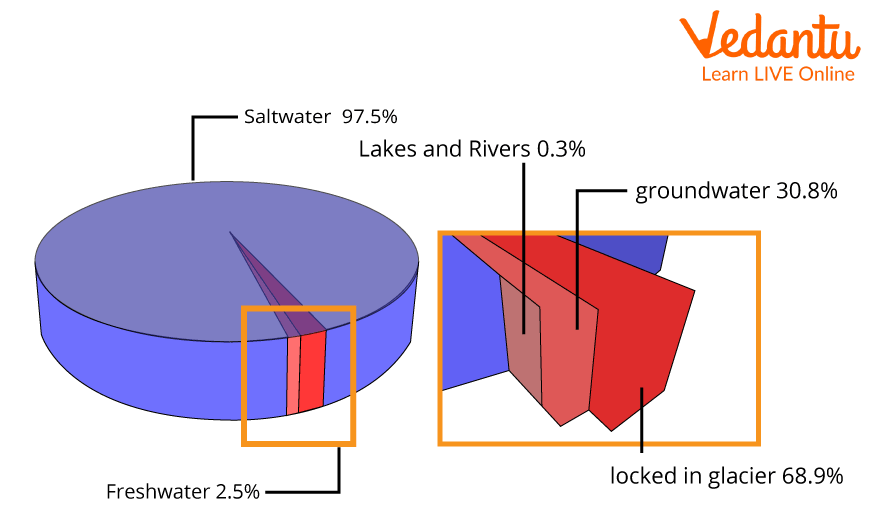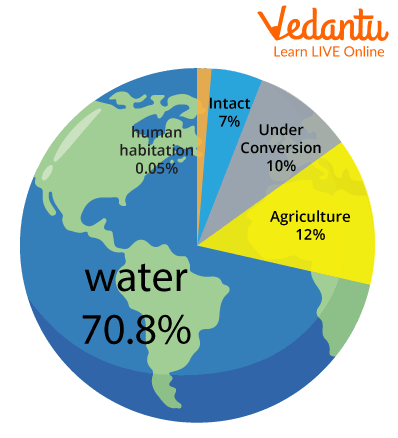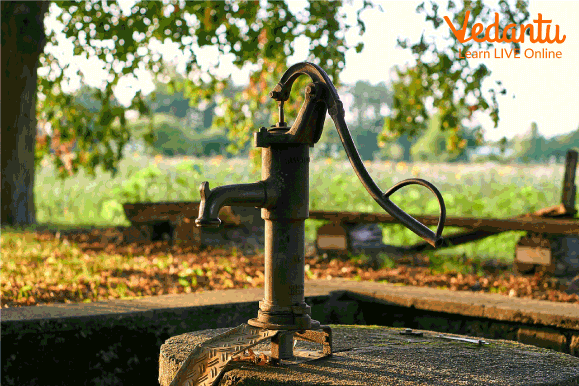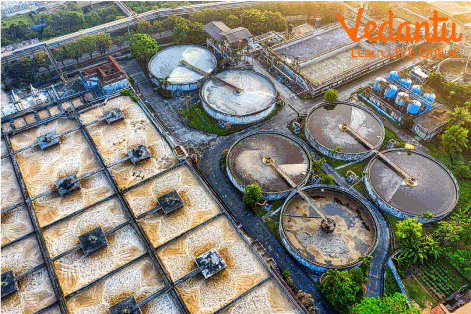




Introduction
Earth is also known as the blue planet because more than half of the Earth’s surface is covered with water. Water is present in oceans, rivers, ponds, and glaciers, but only a small amount of water is fit for humans to drink. The distribution of water on Earth tells us about the amount of water in various resources.

Pie Chart of Water Distribution on Earth
Distribution of Water and Land on Earth
Our planet Earth comprises land and water of which water is present in the majority. The distribution of land and water on Earth in percentage is - water covers approximately 70.8 % of the area while land covers 29.2 %. Water distribution on Earth's surface is highly unequal. Only 3 % of the water on the surface is clean; the other 97 % is in the ocean.
Freshwater is found in glaciers 69 % of the time, underground 30 % of the time, and in lakes, rivers, and swamps less than 1 % of the time. In other words, just 1 % of the water on Earth's surface is consumable for people, while 99 % of the useful quantity is underground.

Pie Chart of Land and Water Distribution On Earth
Types of Water on Earth
There are three different types of water resources in the world.
Surface Water - Surface water is water found in streams and lakes. This water is mostly utilised for drinking water, recreation, irrigation, industry, cattle, transportation, and hydroelectric electricity. The maintenance and purity of surface water are essential.
Saltwater - The planet's surface is rich with salt water. However, saltwater is ineffective when it comes to drinkable water supplies. Many people's diets across the world include saltwater fish. Coastal waters have also been used to create hydroelectric power.
Groundwater - Groundwater is the most abundant freshwater resource. Some of the water that filters down into the ground through layers of soil, clay, and rock, sticks to the highest layers providing water to plants. Gravity keeps the water moving downward through the earth. The water eventually reaches the saturated zone, when all the pores are filled with water. Groundwater feeds surface water through springs, while surface water may also restore groundwater supplies. Humans often obtain groundwater using wells.

Hand Pump Used for Groundwater Extraction
Wastewater Treatment
As the availability of water on Earth for drinking is less in amount, it is necessary to save water and reuse it. The water that we use and goes into the sinks needs to be cleaned to be used again. It goes through three major filtering stages.
First, unclean water is sent through a machine that, like a filter, filters out particles and other waste. That debris is cut into smaller pieces and disposed of in a landfill.
The residual water is then sent to an underground tank. Tiny creatures (bacteria) feed on the waste in the water here.
Finally, the water is sent to oceans, lakes, and rivers, or a final cleaning stage before being used to irrigate farmland or golf courses. After adding chlorine, this cleaned water can also be used as drinking water.

Wastewater Treatment Plant
Sample Questions
1. How much water is present as clean drinking water?
a. 10
b. 3
c. 15
d. 5
Ans. 3
Explanation: Out of 70
2. What is the source of clean drinking water?
a. Seas
b. Salt water lake
c. Wells
d. Oceans
Ans. Wells
Explanation: Rivers, ponds and oceans have salt present in large amounts, which cannot be consumed directly by human beings making it not fit for drinking.
3. ________ is not the source of salt water.
a. Ponds
b. Oceans
c. Rivers
d. Sea
Ans. Ponds and River
Explanation: Oceans and seas have a huge amount of salt dissolved in them naturally. Rivers are natural water sources containing fresh water, whereas ponds are man-made and do not have salt in them.
Conclusion
In this chapter we have studied about the distribution of land and water on earth and other facts like water is dispersed quite unevenly throughout the surface of the earth. The fresh water contains around three percent of earth. And very few percent of fresh water is found in lakes , rivers etc. We have also covered the types of water and how we can stop wasting water by adapting the wastewater treatment.
FAQs on Water Distribution on Earth
1. Name the sources through which fresh water can be obtained.
Glaciers, lakes, reservoirs, ponds, rivers, streams, marshes, and even groundwater are the sources of fresh water.
2. Why can salt water not be used for drinking purposes?
Saltwater is not used for drinking purposes. The water needs to be desalinated (removal of salt from water) in order to make it drinkable. Desalination facilities do exist, but they are limited since the energy necessary for desalination makes the procedure too costly.
3. How can water be conserved?
some of the ways through which water can be conserved are:
Take showers rather than baths.
Close the faucet when brushing your teeth.
Water the plants using a watering can.
To clean the floors, use a bucket.
When shampooing in the shower, turn off the water.
4. More than half of the Earth is covered in water. Why is there water scarcity?
There is water scarcity in the world as the majority of water is available in oceans, rivers, and ponds, which are not fit for human consumption. The water is also present in the frozen form in the glaciers and cannot be used for drinking as it is not clean. Only 3
5. How does water get affected by human activities?
The water gets polluted due to human activities like using excessive amounts of fertilizer or pesticide, dumping debris into storm drains, littering, agricultural runoff, and industrial discharge. This causes the death of aquatic animals and makes the water unfit for agricultural use.









